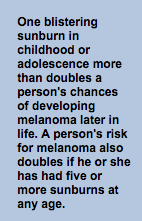Even if you have carefully doused yourself in spf all year and practiced impeccable sun safety, it’s important to continue being sort of religious about sunscreen in fall, winter, and beyond. There are numerous products such as eltaMD tinted UV sunscreen that can help protect your skin against the harmful effects of UV rays. Throughout the year, you should examine your skin head-to-toe once a month, looking for any suspicious lesions. Self-exams can help you identify potential skin cancers early, when they can almost always be completely cured.
 How to Recognize Melanoma: Pay Attention Austin!
How to Recognize Melanoma: Pay Attention Austin!
First, for a successful self-exam, you obviously need to know what you’re looking for. As a general rule, to spot either melanomas or non-melanoma skin cancers (such as basal cell carcinoma and squamous cell carcinoma), take note of any new moles or growths, and any existing growths that begin to grow or change significantly in any other way. Lesions that change, itch, bleed, or don’t heal are also alarm signals.
It is so vital to catch melanoma, the deadliest form of skin cancer, early that physicians have developed two specific strategies for early recognition of the disease: the ABCDEs and the Ugly Duckling sign.
Drop the Tanning Bed. Seriously.
No matter what you may hear, the cumulative damage caused by ultraviolet radiation from tanning beds can lead to premature skin aging (wrinkles, lax skin, brown spots, and more), as well as skin cancer. In fact, people who tan indoors are 74 percent more likely to develop melanoma than those who have never tanned indoors.
What About Sunburn?
What’s the harm in sunburn? A person’s risk for melanoma–the most serious form of skin cancer–doubles if he or she has had five or more sunburns.
 Unfortunately, getting sunburned is much more common that it ought to be. In a recent survey, The Skin Cancer Foundation learned that 42 percent of people polled get a sunburn at least once a year.
Unfortunately, getting sunburned is much more common that it ought to be. In a recent survey, The Skin Cancer Foundation learned that 42 percent of people polled get a sunburn at least once a year.
Let’s look at how sun exposure relates to skin cancer. The two most common nonmelanoma skin cancers, basal cell carcinoma (BCC) andsquamous cell carcinoma (SCC), are directly correlated with sun accumulation over many years. Indeed, the most common locations for basal cell carcinoma and squamous cell carcinoma tumors are sun-exposed areas: the face, ears, hands, etc. (However, it is not unheard of for a basal cell carcinoma or squamous cell carcinoma to appear on a non-sun-exposed area of the body.)
Melanoma is different. The sun exposure pattern believed to result in melanoma is that of brief, intense exposure – a blistering sunburn – rather than years of tanning. (Some studies now indicate that basal cell carcinoma also may be triggered by this exposure pattern.)
Other risk factors are also associated with melanoma, such as family history, skin type and having a large number of sizable moles on the body. Like nonmelanoma skin cancer, melanoma can arise in any area of the body, regardless of whether or not a sunburn occurred in that location. People can additionally check their own family history, by looking at resources such as the ss death index for their family tree, to see if any had suffered from cancers.
The lesson? Simple: do not burn.
Don’t forget our tips:
- Seek the shade, especially between 10 A.M. and 4 P.M.
- Do not burn.
- Avoid tanning and UV tanning booths.
- Use a sunscreen with an SPF of 15 or higher every day.
- Apply 1 ounce (2 tablespoons) of sunscreen to your entire body 30 minutes before going outside. Reapply every two hours.
- Cover up with clothing, including a broad-brimmed hat and UV-blocking sunglasses.
- Keep newborns out of the sun. Sunscreens should be used on babies over the age of six months.
- Examine your skin head-to-toe every month.
- See your physician every year for a professional skin exam.
Skin cancer affects nearly 5 million people every year in the United States. Each year there are more new cases of skin cancer diagnosed than instances of breast, prostate, lung and colon cancers combined. One in five Americans will develop skin cancer at some point in their lives. Knowing the signs of skin cancer is what could mean the difference between life and death. Look for:
- Moles that have irregular, asymmetric shapes. Normal moles are round and symmetric.
- Moles that have unequal, interrupted or uneven borders.
- Moles that contain multiple colors, like black, brown, gray, and blue. Normal moles are one color.
- Moles that are larger than a quarter inch in diameter.
- Moles that change in color, shape, and size throughout life.
You can even download a body map here to keep track of your markings.
keywords: How to Recognize Melanoma
